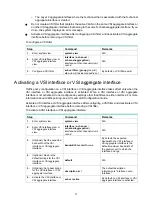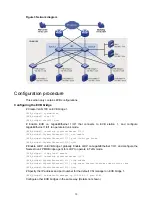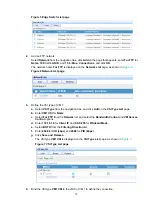
6
Step Command
Remarks
interface view or Layer 2
aggregate interface view.
interface-number
4.
Enable LLDP on the
interface
lldp enable
By default, LLDP is enabled on an
interface.
5.
Configure the Nearest
non-TPMR Bridge agent for
LLDP to operate in TxRx
mode.
lldp agent nearest-nontpmr
admin-status
txrx
The default mode is
disable
.
Specifying a default VSI manager
When the bridge receives a VDP packet (except for de-associate packets) from a station, it obtains
VSI interface resources and policies for the station from the VSI manager specified in the VDP
packet.
The VSI manager ID TLV in a VDP packet carries an IP address of a VSI manager. If the value for the
TLV is 0, the VDP packet does not contain a VSI manager IP address. Perform this task to specify a
default VSI manager for the bridge.
To specify a default VSI manager:
Step Command
Remarks
1.
Enter system view.
system-view
N/A
2.
Specify a default VSI
manager.
evb default-manager
{ {
ip
ipv4-address
|
ipv6
ipv6-address
|
name
name
} [
port
port-number
]
|
local-server
}
By default, no default VSI
manager is specified.
Configuring VDP negotiation parameters
After a station sends a VDP request other than a De-Associate request to the bridge, the bridge
requests the VSI interface resources and policies from the VSI manager. If the bridge does not
receive a response from the VSI manager before the VDP response-wait-delay time expires, the
VDP negotiation fails. The VDP response-wait-delay time on the EVB bridge is calculated by using
the following formula:
VDP response-wait-delay time (seconds) = 2
VDP
resource-wait-delay
× 10
—
5
.
The value of the VDP resource wait-delay exponent is the larger of the values proposed by the
station and bridge through EVB TLV.
When a Pre-Associate, Pre-Associate with Resource Reservation, or Associate request from a
station is successfully handled, the VSI manager notifies the bridge to create a VSI interface for the
corresponding VM. Then the bridge starts a VDP keepalive timer for the VSI interface. If the bridge
does not receive a keepalive from the station before the timer expires, it releases resources reserved
for the association. The VDP keepalive time is calculated by using the following formula:
VDP keepalive time (seconds) = 1.5 × [ 2
VDP
keepalive
+ (2 × ECP maximum retransmission time + 1) ×
2
ECP retransmission
] × 10
—
5
.
The values assigned to the VDP keepalive exponent, the ECP maximum retransmission time, and
the ECP retransmission exponent are the larger of the values proposed for each by the station and
bridge through EVB TLV.
To configure VDP negotiation parameters:


























